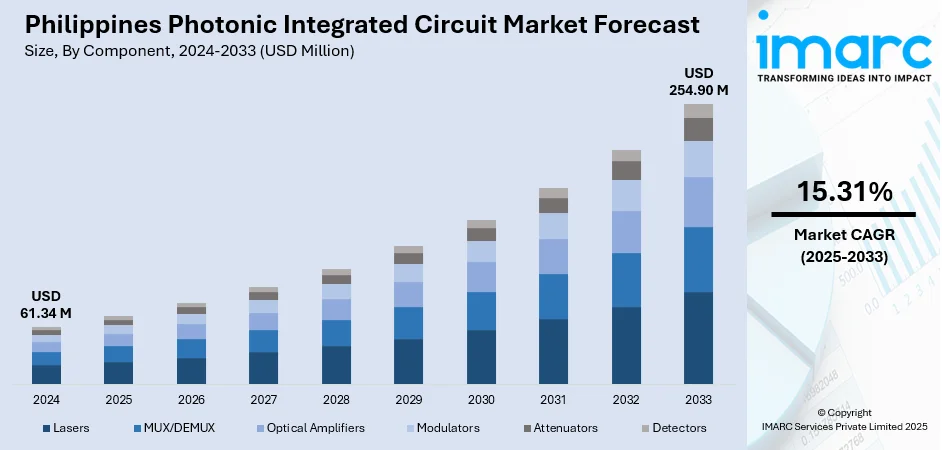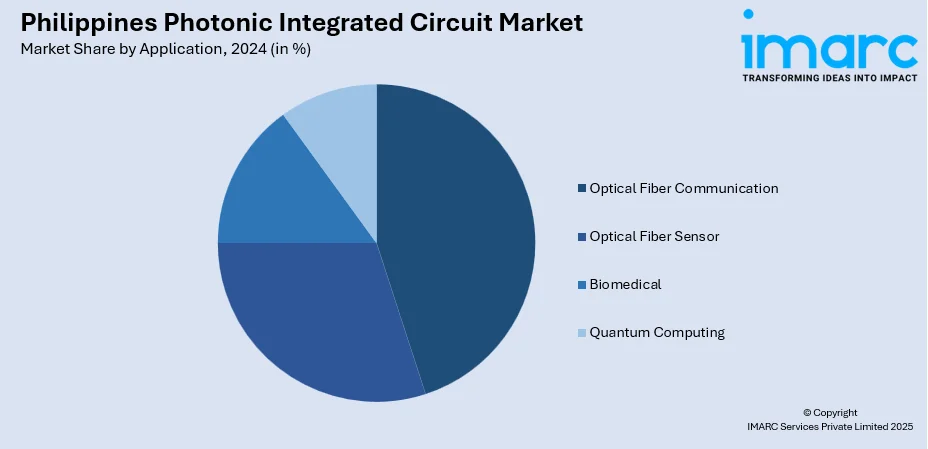
Philippines Photonic Integrated Circuit Market Size, Share, Trends and Forecast by Component, Raw Material, Integration, Application, and Region, 2025-2033
Philippines Photonic Integrated Circuit Market Overview:
The Philippines photonic integrated circuit market size reached USD 61.34 Million in 2024. The market is projected to reach USD 254.90 Million by 2033, exhibiting a growth rate (CAGR) of 15.31% during 2025-2033. Investments in R&D and a growing focus on efficient data transmission are key drivers, fueling the market's growth in various sectors, including telecommunications and healthcare. Moreover, the Philippines photonic integrated circuit market share is expanding due to the increasing demand for high-speed communication networks and advancements in optical technologies.
|
Report Attribute
|
Key Statistics
|
|---|---|
|
Base Year
|
2024
|
|
Forecast Years
|
2025-2033
|
|
Historical Years
|
2019-2024
|
| Market Size in 2024 | USD 61.34 Million |
| Market Forecast in 2033 | USD 254.90 Million |
| Market Growth Rate 2025-2033 | 15.31% |
Philippines Photonic Integrated Circuit Market Trends:
Growing Need for Optical Communication
The Philippines photonic integrated circuit market growth is being driven significantly by the increase in demand for optical communication technology. The introduction of 5G networks and broadband internet services has brought about the necessity to handle large data transmission through advanced solutions. Photonic integrated circuits (PICs) are gaining popularity in the market because they are capable of enabling faster and more efficient data communication than traditional electronic circuits. This is in concordance with the global push for greater connectivity and provision of high-speed internet to urban and rural locations in the Philippines. The use of PICs addresses the bandwidth limitation of conventional electronics, rendering them instrumental in meeting the needs of modern communication networks. The growing telecommunication industry in the nation is urging the implementation of cutting-edge technologies, and PICs are at the forefront of this revolution. As there is more demand for high-bandwidth services and low-latency connections, telecommunications operators are looking for photonics as a solution to meet these requirements. This will, in turn, establish an emerging Philippine market for photonic integrated circuits since the need for better infrastructure and quality communication systems will continue to grow.

To get more information on this market, Request Sample
Increase in Research and Development Spending
There has been continuous growth in research and development expenditure in the Philippine photonic integrated circuit market that further supports its growth. Universities, research institutes, and private businesses increasingly participate in photonics to improve the design, production, and use of photonic integrated circuits. These investments play an important role in the function and performance of PICs for their improved use in telecommunication, health care, and computing. The government is also keen on developing innovation in the photonics sector, where it has established programs encouraging technological advancement and commercialization of research output. By the exchange of local actors with international players, a synergy is generated that is further driving the Philippines to the international market of photonics. Improved PICs that are more cost-efficient and effective should create new avenues in diverse industries, including quantum computing and healthcare diagnostics, where photonics can revolutionize. Through continued government subsidies for innovation and R&D, the photonic integrated circuit industry can further consolidate its hold on the Philippines and propel long-term economic and technology development.
Philippines Photonic Integrated Circuit Market Segmentation:
IMARC Group provides an analysis of the key trends in each segment of the market, along with forecasts at the country and regional level for 2025-2033. Our report has categorized the market based on component, raw material, integration, and application.
Component Insights:
- Lasers
- MUX/DEMUX
- Optical Amplifiers
- Modulators
- Attenuators
- Detectors
The report has provided a detailed breakup and analysis of the market based on the component. This includes lasers, MUX/DEMUX, optical amplifiers, modulators, attenuators, and detectors.
Raw Material Insights:
- Indium Phosphide (InP)
- Gallium Arsenide (GaAs)
- Lithium Niobate (LiNbO3)
- Silicon
- Silica-on-Silicon
A detailed breakup and analysis of the market based on the raw material have also been provided in the report. This includes indium phosphide (InP), gallium arsenide (GaAs), lithium niobate (LiNbO3), silicon, and silica-on-silicon.
Integration Insights:
- Monolithic Integration
- Hybrid Integration
- Module Integration
A detailed breakup and analysis of the market based on the integration have also been provided in the report. This includes monolithic integration, hybrid integration, and module integration.
Application Insights:

- Optical Fiber Communication
- Optical Fiber Sensor
- Biomedical
- Quantum Computing
A detailed breakup and analysis of the market based on the application have also been provided in the report. This includes optical fiber communication, optical fiber sensor, biomedical, and quantum computing.
Regional Insights:
- Luzon
- Visayas
- Mindanao
The report has also provided a comprehensive analysis of all the major regional markets, which include Luzon, Visayas, and Mindanao.
Competitive Landscape:
The market research report has also provided a comprehensive analysis of the competitive landscape. Competitive analysis such as market structure, key player positioning, top winning strategies, competitive dashboard, and company evaluation quadrant has been covered in the report. Also, detailed profiles of all major companies have been provided.
Philippines Photonic Integrated Circuit Market Report Coverage:
| Report Features | Details |
|---|---|
| Base Year of the Analysis | 2024 |
| Historical Period | 2019-2024 |
| Forecast Period | 2025-2033 |
| Units | Million USD |
| Scope of the Report |
Exploration of Historical Trends and Market Outlook, Industry Catalysts and Challenges, Segment-Wise Historical and Future Market Assessment:
|
| Components Covered | Lasers, MUX/DEMUX, Optical Amplifiers, Modulators, Attenuators, Detectors |
| Raw Materials Covered | Indium Phosphide (InP), Gallium Arsenide (GaAs), Lithium Niobate (LiNbO3), Silicon, Silica-on-Silicon |
| Integrations Covered | Monolithic Integration, Hybrid Integration, Module Integration |
| Applications Covered | Optical Fiber Communication, Optical Fiber Sensor, Biomedical, Quantum Computing |
| Regions Covered | Luzon, Visayas, Mindanao |
| Customization Scope | 10% Free Customization |
| Post-Sale Analyst Support | 10-12 Weeks |
| Delivery Format | PDF and Excel through Email (We can also provide the editable version of the report in PPT/Word format on special request) |
Key Questions Answered in This Report:
- How has the Philippines photonic integrated circuit market performed so far and how will it perform in the coming years?
- What is the breakup of the Philippines photonic integrated circuit market on the basis of component?
- What is the breakup of the Philippines photonic integrated circuit market on the basis of raw material?
- What is the breakup of the Philippines photonic integrated circuit market on the basis of integration?
- What is the breakup of the Philippines photonic integrated circuit market on the basis of application?
- What is the breakup of the Philippines photonic integrated circuit market on the basis of region?
- What are the various stages in the value chain of the Philippines photonic integrated circuit market?
- What are the key driving factors and challenges in the Philippines photonic integrated circuit market?
- What is the structure of the Philippines photonic integrated circuit market and who are the key players?
- What is the degree of competition in the Philippines photonic integrated circuit market?
Key Benefits for Stakeholders:
- IMARC’s industry report offers a comprehensive quantitative analysis of various market segments, historical and current market trends, market forecasts, and dynamics of the Philippines photonic integrated circuit market from 2019-2033.
- The research report provides the latest information on the market drivers, challenges, and opportunities in the Philippines photonic integrated circuit market.
- Porter's Five Forces analysis assists stakeholders in assessing the impact of new entrants, competitive rivalry, supplier power, buyer power, and the threat of substitution. It helps stakeholders to analyze the level of competition within the Philippines photonic integrated circuit industry and its attractiveness.
- Competitive landscape allows stakeholders to understand their competitive environment and provides an insight into the current positions of key players in the market.
Need more help?
- Speak to our experienced analysts for insights on the current market scenarios.
- Include additional segments and countries to customize the report as per your requirement.
- Gain an unparalleled competitive advantage in your domain by understanding how to utilize the report and positively impacting your operations and revenue.
- For further assistance, please connect with our analysts.
 Request Customization
Request Customization
 Speak to an Analyst
Speak to an Analyst
 Request Brochure
Request Brochure
 Inquire Before Buying
Inquire Before Buying




.webp)




.webp)












